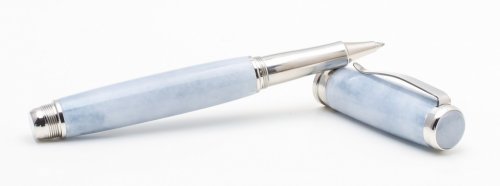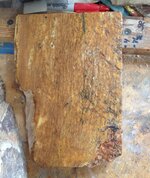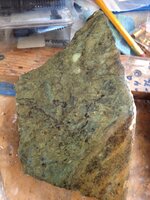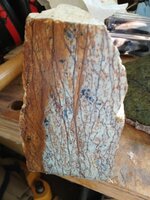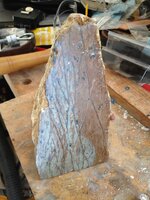Skie_M
Member
Yup, you can do that on a wood lathe.
The question's come up several times, but the answer isn't in the Library and the description of methods used in the IAP Collection just doesn't cut it ... there's not enough detail to really get anybody more than marginally interested, much less actually started turning stone.
First, let's just have a very basic overview before we have the local IAP experts chime in....
Stone comes in various hardnesses. You can use high speed steel for the softer stone, as well as carbide tools, the softer stone being Soapstone and Alabaster. Carbide and Diamond Impregnated tools come along for the harder stones, like Marble and Granite.
It is generally recommended that you start with the softer stone and work your way to harder stone as you refine your techniques.
Softest stones:
Soapstone - This is your typical starting point. This stone is soft enough that you can carve it with a pocketknife. High Speed Steel makes easy work of it, but you'll need to sharpen your steel tools fairly often, perhaps as often as 2 or 3 times for a single pen project. More from our experts on this soon!
Alabaster - This is an absolutely gorgeous stone, but can be tricky to work as it can have very HARD quartz crystals embedded in it that will take the edge right off a steel tool. Carbide is recommended if you think you'll find some quartz in there, when cutting your blanks down to size. After you're at pen blank size, you'll be able to tell if there's any quartz left ... if there is, you don't want to turn it using hard tools. Wet-sanding it all the way down may be the only way to work it without ripping large chunks out, and drilling may present problems as well. If there's no apparent quartz, high carbon steel and high speed steel will work, but you'll have to sharpen your tools much more often, and take lighter cuts than with soapstone. More from our experts soon, hopefully with tips on how to deal with tricky quartz!
Marble - Another truly stunning stone to work with, but the harder the stone, the more fragile it can be to work. High speed steel can still work here, but you may get further faster using metal cutting files and carbide cutters or diamond impregnated tool bits. More from our experts soon, hopefully with more tips and tricks concerning marble!
Granite - The hardest and trickiest stone to work with, as it's origins can combine various quartz crystals and even sedimentary rock through igneous (fiery or molten) processes. Absolutely beautiful, and yet it can be so fragile because it's been highly compressed and is very very hard. You will want carbide tools at a minimum, and you WILL want to invest in diamond tools in a hurry. I hope our experts have a lot to teach us about this beautiful and highly varied rock!
First general tip so far.... before beginning any work with your chosen material, tap it with a hammer to make certain that it's solid ... If you hear a ringing sound, it's likely solid with no cracks or voids. If it's more of a dull thud or thwack, it may have inclusions or cracks and voids within ... you'll want to slice it up and test the various pieces to see which are usable.
Second general tip so far.... You may think that rock is pretty much impervious to the elements .... you're wrong. Where do you think all that sand on the beach came from? Ya know, it didn't start that small. Soapstone and Alabaster are both very soft and porous stones. They can literally DISSOLVE in water. Marble will also sustain water damage when left outside for a long period, but soapstone and alabaster won't last for more than a year, while marble is good for several hundred years. KEEP YOUR STONE INDOORS.
Soapstone and Alabaster are both very soft and porous stones. They can literally DISSOLVE in water. Marble will also sustain water damage when left outside for a long period, but soapstone and alabaster won't last for more than a year, while marble is good for several hundred years. KEEP YOUR STONE INDOORS.
Granite slabs, on the other hand, are commonly kept outdoors for easy viewing in natural light. Oils and greases will stain and damage them, but water doesn't really hurt it much. In any case, keep your small pieces inside anyways so that they don't grow legs and wander off.
Third general tip so far.... Unless you're partial to stains in your finished work (stone can be porous vs water and oils and carry stains into the rock itself), you will want to seal your finished projects with a durable coat to protect it. I'll let our local experts explain which types of finishes they use for which types of rock specimens.
All right, guys, I got the new library file here started ... I'll leave the next few bits to you guys and come back to ask for more details tomorrow!
The question's come up several times, but the answer isn't in the Library and the description of methods used in the IAP Collection just doesn't cut it ... there's not enough detail to really get anybody more than marginally interested, much less actually started turning stone.
First, let's just have a very basic overview before we have the local IAP experts chime in....
Stone comes in various hardnesses. You can use high speed steel for the softer stone, as well as carbide tools, the softer stone being Soapstone and Alabaster. Carbide and Diamond Impregnated tools come along for the harder stones, like Marble and Granite.
It is generally recommended that you start with the softer stone and work your way to harder stone as you refine your techniques.
Softest stones:
Soapstone - This is your typical starting point. This stone is soft enough that you can carve it with a pocketknife. High Speed Steel makes easy work of it, but you'll need to sharpen your steel tools fairly often, perhaps as often as 2 or 3 times for a single pen project. More from our experts on this soon!
Alabaster - This is an absolutely gorgeous stone, but can be tricky to work as it can have very HARD quartz crystals embedded in it that will take the edge right off a steel tool. Carbide is recommended if you think you'll find some quartz in there, when cutting your blanks down to size. After you're at pen blank size, you'll be able to tell if there's any quartz left ... if there is, you don't want to turn it using hard tools. Wet-sanding it all the way down may be the only way to work it without ripping large chunks out, and drilling may present problems as well. If there's no apparent quartz, high carbon steel and high speed steel will work, but you'll have to sharpen your tools much more often, and take lighter cuts than with soapstone. More from our experts soon, hopefully with tips on how to deal with tricky quartz!
Marble - Another truly stunning stone to work with, but the harder the stone, the more fragile it can be to work. High speed steel can still work here, but you may get further faster using metal cutting files and carbide cutters or diamond impregnated tool bits. More from our experts soon, hopefully with more tips and tricks concerning marble!
Granite - The hardest and trickiest stone to work with, as it's origins can combine various quartz crystals and even sedimentary rock through igneous (fiery or molten) processes. Absolutely beautiful, and yet it can be so fragile because it's been highly compressed and is very very hard. You will want carbide tools at a minimum, and you WILL want to invest in diamond tools in a hurry. I hope our experts have a lot to teach us about this beautiful and highly varied rock!
First general tip so far.... before beginning any work with your chosen material, tap it with a hammer to make certain that it's solid ... If you hear a ringing sound, it's likely solid with no cracks or voids. If it's more of a dull thud or thwack, it may have inclusions or cracks and voids within ... you'll want to slice it up and test the various pieces to see which are usable.
Second general tip so far.... You may think that rock is pretty much impervious to the elements .... you're wrong. Where do you think all that sand on the beach came from? Ya know, it didn't start that small.
Granite slabs, on the other hand, are commonly kept outdoors for easy viewing in natural light. Oils and greases will stain and damage them, but water doesn't really hurt it much. In any case, keep your small pieces inside anyways so that they don't grow legs and wander off.
Third general tip so far.... Unless you're partial to stains in your finished work (stone can be porous vs water and oils and carry stains into the rock itself), you will want to seal your finished projects with a durable coat to protect it. I'll let our local experts explain which types of finishes they use for which types of rock specimens.
All right, guys, I got the new library file here started ... I'll leave the next few bits to you guys and come back to ask for more details tomorrow!

